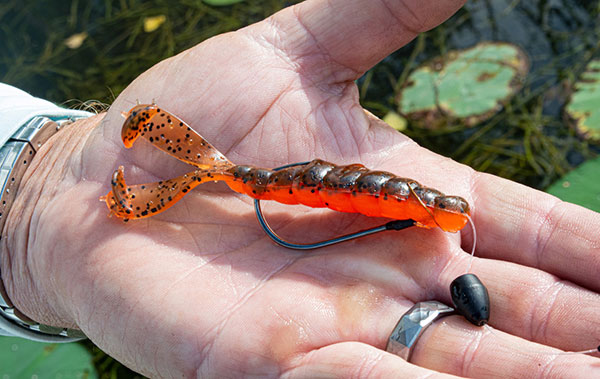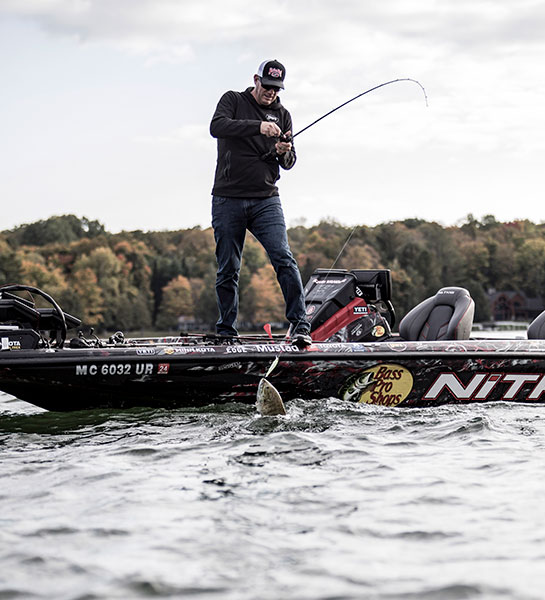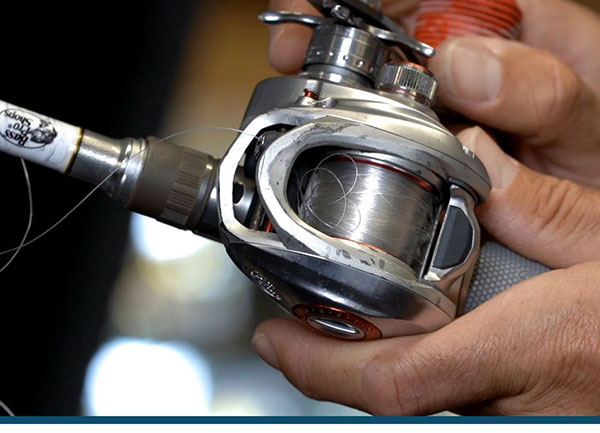- Details
Z-man Report
 Z-man Hella CrawZ™
Z-man Hella CrawZ™
While ElaZtech’s Z-man lure qualities produce livelier underwater movement and more fish per bait, they come with a learning curve, especially when rigging the baits.
Here is how some of the company’s pros rig theirs:
Light-Duty Weedless
“Because the material is so soft and flexible, it compresses easily,” explains MLF Pro David Walker. “This makes ElaZtech baits super effective when rigged on an exposed hook. Baits like the Finesse TRD™ or a MinnowZ™ on a jighead are great fish catchers—and fish-hookers. It’s because their free-flowing movements elicit strikes; and because the soft compressible material moves out of the way and allows the hook to penetrate.
“With Texas rigging, it’s a slightly different story,” he admits. “Keeping the hookpoint hidden in the soft material was the first challenge, but also a great exercise in learning how ElaZtech works.” Following countless trials with different hooks and rigging configurations, Walker, Feider and other pros landed on specific schemes that produce high-percentage hookset ratios.
For Walker, rigging routines for baits like the Hella CrawZ™, Turbo CrawZ™ or Palmetto BugZ depend on light versus heavy flipping situations. In light cover, Walker leans on the Palmetto BugZ, rigging it on a 4/0 wide gap EWG hook. “Slide the hookpoint into the bait’s head and back out about three-quarters of an inch down,” he explains. “Rotate the bait 180-degrees and pull the body slightly forward before planting the hook back into the bait’s belly, pushing the hookpoint just through the material. Then, slide just a ‘skin’ of ElaZtech back over the hookpoint for a light barrier of protection.
- Details
By Kevin VanDam
 Kevin VanDam
Kevin VanDam
As water temperatures drop rapidly – as they have in the north right now – bass move into winter patterns and several techniques can catch them.
For me, though, it’s tough to beat a deep diving jerkbait worked around drop-offs, edges, weedlines, bridge corners, riprap, bluff ends and places like that that cold water bass use.
I do fish the jerkbait slower than I do during other times of the year and pay close attention to boat positioning to insure my lure stays in the strike zone longer on those places I think the bass are using.
When I say I slow down, I don’t go as slow as a lot of people do. It’s still a very efficient technique for covering a good bit of water, so by fishing parallel to edges, I keep the lure in the productive zone throughout the retrieve.
Typically, our lakes are pretty clear throughout the country right now. To fish the jerkbait, I like water clarity of 3 to 4 feet or deeper. Crystal clear water is ideal.
I prefer the Strike King KVD Deep Diving Jerkbait in real bright colors – sexy shad and chartreuse sexy shad are my favorites – even in clear water. After all, it’s about getting the fish to see the bait when they are far away.
- Details
Mercury Report
 Baitcaster with backlash
Baitcaster with backlash
Getting a backlash while using a baitcasting reel is part of fishing. It just happens, even to the best and most experienced casters. So, when you do get a backlash, what’s next?
According to Mercury Pro Team angler and 2019 Bassmaster Classic champ Ott DeFoe, the first thing to do is stop and stay calm.
“It’s going to be OK, and you’re going to get this out,” he said.
The Blaine, Tennessee, angler believes that most people attack a backlash too aggressively – probably in part due to frustration.
“Most people immediately engage the spool, put their thumb on the spool and start pulling on the line. That’s not the best way to get out a backlash,” said DeFoe. “That method often makes the line bind back up even worse.”
DeFoe knows from experience that there’s a better way and offered an advanced method that’s surprisingly effective with only three simple steps:
- Tighten the spool tension knob tighter than you ever would if you were going to cast.
- Depress the thumb bar and then slowly and steadily pull line off the reel. “The spool tension knob being tight will keep the line from getting locked up underneath itself,” DeFoe added. “A lot of times, this process is all you need, and you can pull all the tangles out.”
- Whenever you hit a point where the line locks up, apply thumb pressure to the spool in line with where the line is jammed. Then tighten the drag, engage the reel handle and slowly turn the handle two complete revolutions while maintaining thumb pressure. Now press the thumb bar and slowly pull the line off again like in Step 2. “Step 3 will sometimes need repeating, but usually the first or second time will do the trick,” said DeFoe.
You can see these steps in action at the video down below.
Finishing the Job
Make sure and get the backlash completely cleared. The line should look like when it was initially spooled, with no lines crossed underneath and no loops.
When reeling the line back onto the spool, keep tension on the line by reeling it through the thumb and index finger of your off hand. At some point, a kink may develop in the loose line. Slowly pull the line out at that spot to keep it from binding into a knot.
If you’re on the water going through DeFoe’s process, pull all the line out from end of the rod and let it fall in the water before reeling it back in. It’ll be less likely to tangle and form a knot.
Back to Casting
Once the line is back on the reel, loosen the spool tension knob back to where it was originally, and the process is complete. However, consider adjusting the knob to avoid future backlashes.
DeFoe offers a video on how to set up a baitcaster and utilize the spool tension knob on his YouTube channel here.





